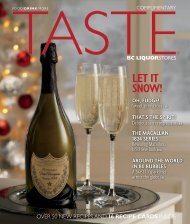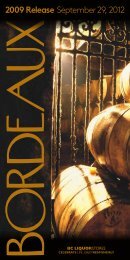Create successful ePaper yourself
Turn your PDF publications into a flip-book with our unique Google optimized e-Paper software.
flips and pickups, but more recently<br />
the egg white has resurfaced in<br />
some of today’s most tantalizing<br />
cocktails, such as the bourbon<br />
sour, silver gin fizz and<br />
margarita. The egg white’s main<br />
purpose is as a binding agent and<br />
as a bonus, it creates a gorgeous<br />
froth on top. Be sure to use fresh, cold<br />
organic eggs at home.<br />
equipmeNt<br />
First, the shaker. Although there are<br />
many styles available, nothing beats a<br />
Boston shaker. The metal<br />
bottom is filled with ice and<br />
ingredients and the glass top<br />
fits on tightly. With this style<br />
of shaker, a strainer is required<br />
to separate the liquid from the<br />
ice. Some cocktails call for “the<br />
shake.” Here’s where we get<br />
some exercise. You must shake the<br />
ingredients with ice vigorously,<br />
with all your might, for at least<br />
15 seconds. Other recipes call for<br />
“the stir,” which is a gentle swirl<br />
with ice using a standard 11-inch bar<br />
spoon. If the recipe doesn’t specify<br />
a mixing style, here’s the rule of<br />
thumb: for recipes<br />
using spirits only,<br />
stir gently over ice<br />
for about 30 seconds,<br />
for recipes using spirits<br />
combined with nonalcoholic<br />
ingredients, shake<br />
vigorously.<br />
A standard bar strainer<br />
will keep the cubes out of your finished<br />
masterpiece but using a fine mesh sieve<br />
between your strainer and glass will<br />
catch any small bits like fruit pulp and ice<br />
shards and maintain the clarity of your<br />
cocktail. Most recipes will instruct you<br />
to use a particular glass but the choice<br />
of glassware is absolutely a personal<br />
preference. Whatever your choice, be<br />
sure to chill your glasses first.<br />
You might also want to have a<br />
“muddler” on hand. After all, you can’t<br />
make a mojito without one! Muddling<br />
is a technique where fresh ingredients<br />
such as citrus fruit and herbs are mashed<br />
together to release and combine their<br />
essences. Most commercially available<br />
muddlers are wooden, although some<br />
high-tech plastic and silicone versions<br />
are now being produced.<br />
measuremeNts<br />
Adhering to recipe measurements is key.<br />
With alcohol, a slight variation here and<br />
there will not alter the taste too much, but<br />
where it counts is with acid to sugar balance.<br />
A simple ratio if you’re creating your own<br />
drinks is: ¾ oz of acid to 1 oz of sugar.<br />
Taste your cocktail before you<br />
commit to the pour. What are you<br />
looking for? Balance. Your drink, if the<br />
recipe is followed perfectly, should not<br />
be puckering in acidity, nor should it<br />
be sugary sweet. If the correct acid to<br />
sugar ratio is used, you will likely achieve<br />
balance every time.<br />
Presentation is important. Please<br />
the eyes before the taste buds. A<br />
cocktail should look clean, refreshing<br />
and appetizing. The use of a garnish,<br />
showcasing a particular flavour in<br />
the cocktail, assists the fragrance, the<br />
appearance and ultimately the taste. Even<br />
a simple twist of lemon goes a long way.<br />
a last tip<br />
Always make sure you have plenty<br />
of ice on hand and never use the<br />
same ice twice! Cheers!<br />
TASTE 41





